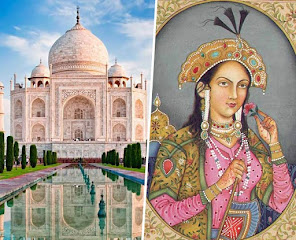Taj Mahal: The Jewel of India's Architectural Heritage

The Taj Mahal is one of the most iconic and celebrated monuments in India, and indeed the world. Located in the northern city of Agra, the Taj Mahal is a testament to the skill and creativity of the Mughal Empire, which ruled India from the 16th to the 18th centuries.
Built between 1632 and 1653 by Emperor Shah Jahan in memory of his beloved wife, Mumtaz Mahal, the Taj Mahal is a masterpiece of Mughal architecture. The monument's symmetrical design, intricate carvings and inlays, and elegant calligraphy are a blend of Persian, Indian, and Islamic architectural styles, reflecting the cultural diversity and artistic sophistication of the Mughal era.

One of the most striking features of the Taj Mahal is its white marble exterior, which changes color depending on the time of day and the quality of light. At dawn and dusk, the monument takes on a golden hue, while in the bright afternoon sun, it shines brilliantly white. The marble used in the Taj Mahal is of the highest quality, sourced from across India and beyond, including Rajasthan, Punjab, and Afghanistan.
The Taj Mahal is a monument to love, devotion, and human creativity. The story of Shah Jahan and Mumtaz Mahal's romance has inspired countless artists, poets, and writers, who have celebrated their love as a timeless and enduring bond. Shah Jahan was so devastated by his wife's death that he vowed to build a monument that would immortalize their love and devotion. He spared no expense in realizing this vision, and the result is one of the most spectacular and awe-inspiring monuments in the world.
The Taj Mahal is more than just a beautiful monument, however. It is also a symbol of the Mughal Empire's cultural and historical legacy. The Mughals were renowned for their patronage of the arts, and the Taj Mahal is a perfect example of the empire's artistic sophistication and cultural diversity. The monument's symmetrical design, intricate carvings and inlays, and elegant calligraphy are a testament to the Mughals' commitment to order, harmony, and balance, while its blend of Persian, Indian, and Islamic architectural styles reflects the empire's cosmopolitanism and cultural fusion.
Despite its enduring popularity, the Taj Mahal faces several challenges today. Air pollution, overcrowding, and damage from natural disasters have all taken a toll on the monument over the years. To ensure its preservation for future generations, the Indian government has launched several initiatives to protect the monument, including strict regulations on visitors and pollution, and conservation efforts to repair and restore the structure.
In recent years, the Taj Mahal has also become a symbol of India's economic potential and cultural diversity. The monument attracts millions of visitors each year from all over the world, generating significant revenue for the local and national economy. It has also become a symbol of India's commitment to preserving its cultural heritage and promoting tourism as a driver of economic growth.

In conclusion, the Taj Mahal is a jewel of India's architectural heritage, a testament to human creativity, devotion, and cultural fusion. Its enduring beauty and cultural significance continue to inspire awe and wonder, and its legacy as a cultural and historical treasure is firmly entrenched in the hearts and minds of people everywhere. As we continue to appreciate and protect this remarkable monument, we can learn valuable lessons about the power of art, history, and human ingenuity to shape our world.





Post a Comment